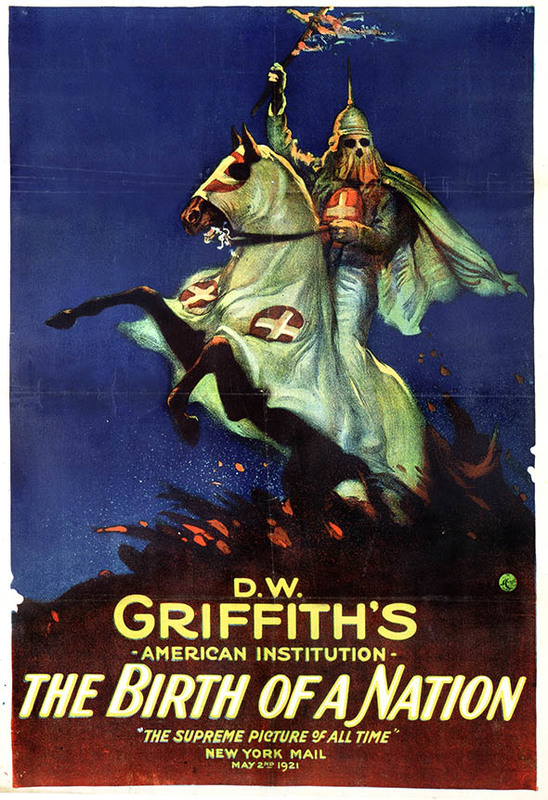Title
The Birth of a Nation (1915)
Creator
D. W. Griffith
Description
The Birth of a Nation (1915), directed by D. W. Griffith, chronicles the formation of the Ku Klux Klan (KKK) in the South. Beginning on the eve of the Civil War and ending in the post-Reconstruction era, the film follows the lives of two families: the Northern Stonemans and the Southern Camerons. The Stonemans are abolitionists who fight for the Union Army, while the Camerons fight for the Confederacy and oppose Reconstruction after the war. The film depicts the KKK as acting nobly, in defense of a reunited nation, and represents African American men as murders and rapists. This silent picture debuted during the most racist era in United States history, frequently referred to by historians as the “nadir of race relations.” After seeing the film, white Southerner and sitting president, Woodrow Wilson, commented, “It is like writing history with lighting, and my only regret is that it is all so terribly true.” As one representation of the Civil War era in popular culture, The Birth of a Nation stands testament to contested notions of black citizenship during the Wilson presidency and in the years leading up to the United States’ entrance into World War I.
D.W. Griffith adapted The Birth of a Nation from Thomas Dixon’s The Clansman, an Historical Romance of the Ku Klux Klan, published in 1905. Both Griffith and Dixon used their work to rewrite the history of the United States during the Civil War and Reconstruction. The director admitted his intention was to capture a sense of national unity. He stated, “The real purpose of my film was to revolutionize Northern audiences [and] transform every man into a Southern man.” Though considered one of the first modern films and praised by moving picture scholars for its imaging techniques, The Birth of a Nation capitalized on white fear of African Americans and the idea of a racially integrated nation. As whites reacted to the themes portrayed in the film, riots broke out across the nation and the NAACP called for its removal from theaters. Not surprisingly, the Klan was invigorated by the film’s release and launched a membership campaign to exploit its success. Producers and directors also capitalized on The Birth of a Nation’s popularity, quickly crafting many movies in its likeness.
Scholars note The Birth of a Nation exemplifies the ways in which popular culture, rather than professional historical literature, has influenced American perceptions of the Civil War and Reconstruction. For example, the film portrays the lynching of black men as a private, orderly affair, not as the gruesome public spectacle these events actually were. The film essentially romanticized the Klan and acted as an apology for Jim Crow segregation and white supremacist politics that would influence not only the South, but also social policies in the West and North, for many years to come.
D.W. Griffith adapted The Birth of a Nation from Thomas Dixon’s The Clansman, an Historical Romance of the Ku Klux Klan, published in 1905. Both Griffith and Dixon used their work to rewrite the history of the United States during the Civil War and Reconstruction. The director admitted his intention was to capture a sense of national unity. He stated, “The real purpose of my film was to revolutionize Northern audiences [and] transform every man into a Southern man.” Though considered one of the first modern films and praised by moving picture scholars for its imaging techniques, The Birth of a Nation capitalized on white fear of African Americans and the idea of a racially integrated nation. As whites reacted to the themes portrayed in the film, riots broke out across the nation and the NAACP called for its removal from theaters. Not surprisingly, the Klan was invigorated by the film’s release and launched a membership campaign to exploit its success. Producers and directors also capitalized on The Birth of a Nation’s popularity, quickly crafting many movies in its likeness.
Scholars note The Birth of a Nation exemplifies the ways in which popular culture, rather than professional historical literature, has influenced American perceptions of the Civil War and Reconstruction. For example, the film portrays the lynching of black men as a private, orderly affair, not as the gruesome public spectacle these events actually were. The film essentially romanticized the Klan and acted as an apology for Jim Crow segregation and white supremacist politics that would influence not only the South, but also social policies in the West and North, for many years to come.
Source
Michele Faith Wallace, “The Good Lynching and The Birth of a Nation: Discourses and Aesthetics of Jim Crow,” Cinema Journal 41 No. 1 (2003): 85-104.
Date
1915
Director
D. W. Griffith
